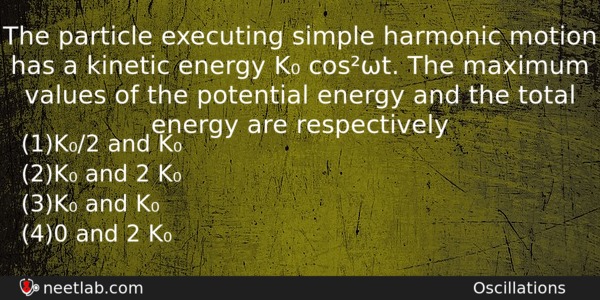| ⇦ | 
| ⇨ |
The particle executing simple harmonic motion has a kinetic energy K₀ cos²ωt. The maximum values of the potential energy and the total energy are respectively
Options
(a) K₀/2 and K₀
(b) K₀ and 2 K₀
(c) K₀ and K₀
(d) 0 and 2 K₀
Correct Answer:
K₀ and K₀
Explanation:
Kinetic energy + Potential energy = total energy
When kinetic energy is maximum, potential energy is zero and vice versa.
.·. Maximum potential energy = total energy
0 + K₀ = K₀
(K.E + P.E = Total energy) .
Related Questions: - Which of the following is a vector quantity?
- A hollow sphere of charge does not produce an electric field at any
- A gas of monoatomic hydrogen is bombarded with a stream of electrons
- If the band gap between valence band and conduction band in a material is 5.0 eV,
- When a beam of light is used to determine the position of an object,
Topics: Oscillations
(58)
Subject: Physics
(2479)
Important MCQs Based on Medical Entrance Examinations To Improve Your NEET Score
- Which of the following is a vector quantity?
- A hollow sphere of charge does not produce an electric field at any
- A gas of monoatomic hydrogen is bombarded with a stream of electrons
- If the band gap between valence band and conduction band in a material is 5.0 eV,
- When a beam of light is used to determine the position of an object,
Topics: Oscillations (58)
Subject: Physics (2479)
Important MCQs Based on Medical Entrance Examinations To Improve Your NEET Score
18000+ students are using NEETLab to improve their score. What about you?
Solve Previous Year MCQs, Mock Tests, Topicwise Practice Tests, Identify Weak Topics, Formula Flash cards and much more is available in NEETLab Android App to improve your NEET score.
Share this page with your friends

Leave a Reply